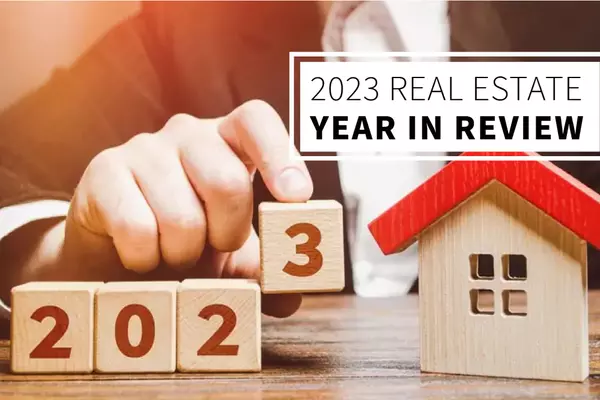
5 Things to Expect in the 2024 Housing Market
As we step into a new year, the housing market continues to be a topic of keen interest for prospective buyers, sellers, and real estate enthusiasts. The real estate market is inherently dynamic, influenced by a variety of factors, including economic conditions, housing supply, and buyer preferences. Here’s what you can expect in the 2024 New Year housing market and provide insights into key trends and considerations. Continued Demand for Housing - The demand for housing is expected to remain robust in 2024. A growing population, favorable mortgage rates, and the desire for homeownership are key drivers. However, this demand can also contribute to the ongoing challenge of housing affordability, especially for first-time buyers. Mortgage Rates and Interest Rates - Mortgage rates and interest rates are pivotal in the housing market. In 2024, interest rates are anticipated to remain relatively stable, with moderate increases possible. Buyers and homeowners should closely monitor these rates, as they can impact affordability and the cost of borrowing. Housing Inventory - The availability of housing inventory will continue to be a critical factor in the housing market. A shortage of homes for sale has been a consistent challenge in recent years, driving up prices and creating competitive bidding situations. It's unclear whether this trend will ease significantly in 2024, but buyers should be prepared to act swiftly when the right property becomes available. Home Prices and Appreciation - Home prices are expected to continue their upward trajectory, although the rate of appreciation may vary by location. High-demand areas may experience more rapid price growth, while other regions may see more moderate increases. Sellers may benefit from increased property values, while buyers should budget accordingly. Housing Preferences - The rise of remote work has shifted the dynamics of the housing market. Buyers are no longer bound to living near their workplaces, leading to increased interest in suburban and rural areas. In 2024, expect to see continued demand for properties that offer a balanced lifestyle and easy access to green spaces. Sustainability and energy efficiency remain top priorities for homebuyers. Eco-friendly features, such as solar panels, efficient HVAC systems, and green building materials, are appealing to those seeking to reduce their environmental impact and lower utility costs. As demographics evolve, multigenerational living arrangements and aging-in-place solutions are becoming more prevalent. Homes with flexible layouts and features to accommodate multiple generations will likely gain popularity.

2023 Real Estate Year in Review
The year 2023 was a dynamic and transformative one for real estate, marked by notable shifts in the market. Check out this overview of the 2023 real estate year in review, offering insights into what transpired. Market Trends and Pricing2023 was marked by several key trends in the real estate market: Pricing and Affordability: The year saw a continued rise in housing prices in many regions, leading to increased concerns about housing affordability. This trend was driven by a combination of low housing inventory, strong demand, and low-interest rates. As a result, buyers faced significant challenges, particularly first-time homebuyers. Urban Revival: Many urban areas experienced a resurgence as people sought a return to city living. Downtowns and urban cores regained popularity, with a focus on mixed-use developments and amenities. Secondary and Suburban Markets: On the flip side, secondary and suburban markets continued to attract buyers and investors. Lower housing costs, more space, and improved remote working opportunities were key drivers in these areas. Technology and Virtual SolutionsTechnology continued to play a pivotal role in the real estate sector: Virtual Home Tours: Virtual tours, 3D walkthroughs, and augmented reality became more common as buyers sought ways to explore properties remotely. These technologies allowed buyers to make informed decisions without visiting properties physically. Digital Transactions: Digital tools and platforms made it easier for buyers and sellers to complete transactions remotely. The convenience of online contracts and electronic signatures streamlined the buying and selling process. Data Analytics: Real estate professionals increasingly relied on data and analytics to gain insights into market trends and buyer preferences. Predictive analytics and machine learning helped forecast future market developments. Sustainability and Energy EfficiencySustainability and energy efficiency remained a top priority in the real estate industry: Green Building: Eco-friendly and energy-efficient homes gained popularity, driven by a growing awareness of climate change and a desire to reduce utility costs. Green building certifications and practices became a standard consideration for new construction and renovations. 2. Solar Power: Solar energy adoption continued to increase in residential real estate. Solar panels and renewable energy solutions not only reduced carbon footprints but also attracted eco-conscious buyers. Regulatory and Policy Changes2023 brought about regulatory and policy changes that impacted the real estate landscape: Interest Rates: The Federal Reserve adjusted interest rates, which affected mortgage rates. While rates remained relatively low, changes influenced the affordability of housing for buyers. Tax Incentives: Some governments introduced tax incentives to encourage sustainable home improvements and solar energy adoption. These incentives had a notable impact on the renovation and solar energy markets. Challenges and Opportunities2023 presented both challenges and opportunities for the real estate industry: Inventory Shortages: A shortage of available homes continued to challenge the market. For sellers, this meant potential price increases, while buyers faced fierce competition and had to act quickly. Remote Work: The rise of remote work created opportunities for homebuyers to explore more diverse geographic locations. This led to increased interest in suburban and rural areas, where people could balance work and lifestyle.

6 Top Real Estate Trends to Watch in Q4
As we head into the final quarter of 2023, it's crucial for buyers, sellers, and investors to stay informed about the latest trends shaping the market. Top real estate trends to keep an eye on for the remainder of the year: 1. Continued Inventory Challenges: The shortage of available homes has been a prominent trend in recent years, and it's expected to persist in Q4 2023. Low housing inventory can lead to increased competition among buyers and rising property prices. For sellers, this quarter is a great time to put your home on the market. 2. Rising Interest Rates: Mortgage interest rates are expected to gradually increase in the coming months. This could impact affordability for some buyers, prompting them to make purchase decisions sooner rather than later. 3.Hybrid Workforce and Housing Preferences: As remote and hybrid work arrangements become more common, buyers may prioritize homes with dedicated office spaces and high-speed internet access, even as they seek more suburban or rural locations. 4. Smart Home Technology Integration: Homes equipped with smart technology, including security systems, thermostats, and lighting, continue to appeal to tech-savvy buyers looking for convenience and energy savings. 5. Demand for Multigenerational Housing: The desire for multigenerational living arrangements has grown. Homes with in-law suites or adaptable spaces are increasingly sought after by families looking to accommodate multiple generations under one roof. 6. Short-Term Rental Investments: Investors may continue to explore opportunities in short-term vacation rentals, driven by the return of travel and the potential for higher rental income.
Categories
Recent Posts









